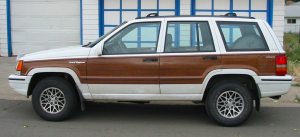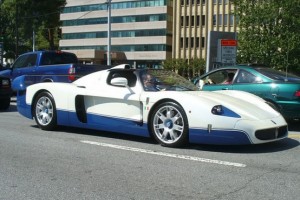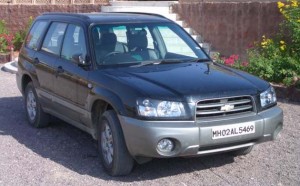1993 Jeep Grand Wagoneer: Ridiculous Rebadge
Posted by Doug DeMuro in Ridiculous Rebadge on | 9 comments
We’ve been recently discussing the Jeep Grand Wagoneer over on TTAC, which has reminded me of a very unusual used car: the second-generation Jeep Grand Wagoneer.
No, I’m not talking about the various facelifted and updated versions of the original Grand Wagoneer, which came out in the 1960s and used the same outdated chassis for decades. I am instead referring to the 1993 Grand Wagoneer, which was really just a rebadged Grand Cherokee.
Here’s what happened: when Chrysler ditched the Grand Wagoneer in the early 1990s, they were highly afraid of losing loyal customers. That makes sense, as many Grand Wagoneer owners were old-money car shoppers who really didn’t want anything else.
So, to keep things familiar when the Grand Cherokee came out, Jeep created a trim level designed to capture Grand Wagoneer buyers. It was, quite simply, the Jeep Grand Wagoneer, even though it was actually just a Grand Cherokee with wood on the side.
The result of this was that, like many Chrysler rebadges, precisely no one was fooled. The Grand Wagoneer sold in tremendously small numbers, and I don’t remember the last time I actually saw one on the road. But it didn’t matter: the Grand Cherokee was such a success that Jeep sort of forgot about those high-end Grand Wagoneer buyers it once owned. In turn, they forgot about Jeep, instead buying the Land Rover Defender (or just a refurbished Grand Wagoneer) in the ensuing years.
But if you ever see a first-gen Grand Cherokee with wood on the side, remember: it isn’t a Grand Cherokee, but rather a Grand Wagoneer. And it’s definitely a 1993.
Maserati MC12: Ridiculous Rebadge
Posted by Doug DeMuro in Ridiculous Rebadge on | 6 comments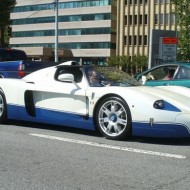
Let’s get one thing settled right away: the Maserati MC12 is not a “rebadge.” You won’t find another vehicle that shares any exterior components with the MC12, except for possibly a large sailing yacht. (Seriously, why is the MC12 so big?)
But most people don’t realize that Maserati’s “halo car” is little more than a rebodied Ferrari Enzo. The two vehicles ride on the same mid-engine chassis, use the same 6.0-liter V12, and even share a transmission, which Maserati renamed “CambioCorsa” instead of Ferrari’s “F1.” To me, this is reminiscent of Chevrolet’s “MyLink” versus Buick’s “IntelliLink,” though admittedly the price points are rather different.
So the MC12 isn’t a strict rebadge, but you have to admit it’s still rather absurd. Rebadging is usually done in conjunction with marketing to convince the less intelligent among us that a Ford really is different from a Mercury. But the MC12/Enzo mishmash is proof that there isn’t a single segment immune to the wiles of a clever marketing department and an automaker eager to save some cash.
Unlike most rebadges, however, this is one I can live with. Both the Enzo and the MC12 are tremendously cool, as you’d expect them to be at more than $1 million. And they’re both highly distinctive on the road. The Enzo, for instance, looks like it’s ready to attack, while the MC12 looks like a fairly large relief map of snow-covered mountains.
In all seriousness, I will say this: I once saw an MC12 on the street. And while it was big and quite certainly overstyled, it was certainly a beautiful car – no matter what was underneath.
Skoda Superb: Ridiculous Rebadge
Posted by Doug DeMuro in Ridiculous Rebadge on | 6 comments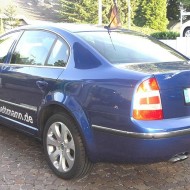
It’s rare to see actual rebadges in today’s world. Mostly, cars people call “rebadged” are a lot more than a grille swap and some new wheels. Usually they share mechanical components and architecture, but not actual body anels
That isn’t true in this case.
Behold the 2001-2006 Skoda Superb, which is precisely identical to the Volkswagen Passat in basically every way. How they thought this would fly is absolutely beyond me, though they may have hoped that changing the tail lights meant no one would notice.
Well, I did notice, and I’m appalled. (Which means I will write this article and probably never think of the car again, except whenever someone says the word “superb.”) Presumably, the Eastern Europeans who comprise Skoda’s target market didn’t have such a negative reaction, since Volkswagen actually sold a version of the Superb in Europe with a Rolls-Royce Phantom-style umbrella in the door. So your chauffeur can shield you from the rain as you step from your Passat clone.
Anyway, the latest Superb is much different than the Passat, which is a vast step forward for the company. And there’s a silver lining: if you have a B5.5 Passat and you live in a non-Skoda Superb market, you can probably do a full conversion. Slovakian immigrants would be impressed. Especially if you had that door umbrella.
Chevrolet Forester: Ridiculous Rebadge
Posted by Doug DeMuro in Ridiculous Rebadge on | 10 comments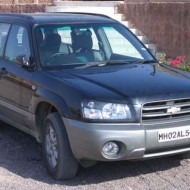
No, that image isn’t a Photoshop. At some point, this actually happened.
The Subaru Forester, as we all know, is reliable transportation for people who live in New Hampshire, and also lesbians. It’s also reliable transportation for people who live in India. But in India, lesbians don’t buy it. Partially because lesbianism has not yet reached India, but also because over there, it doesn’t carry the Subaru badge.
Instead, Indians know the Subaru Forester as the Chevrolet Forester.
Yes, it’s precisely the same vehicle as the one sold in America. All-wheel drive. That 2.5-liter flat-four that’s quickly becoming Subaru’s version of the 3800 V6. Styling done by a committee of people who responded to an ad in the newspaper looking for individuals without a personality. We often hear the term “rebadge” to describe a car that’s mechanically identical, but visually different. Not so here: the Chevrolet Forester is quite literally a Subaru Forester with a bowtie slapped on the front.
So how did this happen?
When the Forester went on sale in the late ‘90s, General Motors owned a stake in Fuji Heavy Industries, which is the company that owns Subaru. And since General Motors is hell-bent on rebadging every car ever made so the Chevrolet name can go worldwide, Subaru was a logical choice to teach India about Chevrolet.
Of course, all good things must come to an end – a saying that apparently applies to bad things, too. In 2005, GM sold its Fuji stake for $740 million, or about enough to pay factory workers’ pensions for eleven hours. The Chevrolet Forester died, bringing an end to one of the most ridiculous rebadges in automotive history.
Pontiac G5: Ridiculous Rebadge
Posted by Doug DeMuro in Ridiculous Rebadge on | 6 comments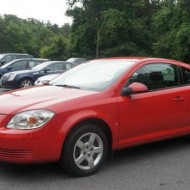
A lot of people really hate two-door cars. I know this because I recently reserved a full-size car for take a road trip with friends, but was so eager to drive the Fiat 500 that I cunningly upgraded to it when I arrived at the rental car agency. My passengers didn’t view this as an upgrade, a fact which was hammered into my head over the following nine hours:
“I can’t feel my legs anymore!”
“I can’t breathe in this tiny little box!”
“Do you still write that stupid car blog?”
The popularity of four-door cars over two-door cars is what makes the latest Ridiculous Rebadge so patently ridiculous.
In the photo above, you might see a Chevrolet Cobalt. But you’re wrong. Instead, that’s a Pontiac G5, also called the G4 in Mexico where it was, apparently, one less. But while the Cobalt was offered as a coupe or a far more popular sedan, the G5 was only available with two doors.
The year was 2007, and General Motors was in its “pride before the fall” phase, where it was rebadging everything in sight with an ultimate goal of trying to whittle its product offerings down from SUVs, cars, and trucks to just one single vehicle with slightly different headlights shared between seven brands.
The G5 fell victim to one of the worst rebadges, since it was hampered by both its two-door bodystyle and its Chevrolet Cobalt underpinnings. That meant in addition to a rough ride, mediocre styling and an interior made from Wal-Mart deck chair plastic, the G5 had the added bonus of back seats that were both inaccessible and inhospitable for any actual human beings, but possibly acceptable for cats.
Not surprisingly, the G5 lasted only three model years before General Motors pulled the plug on its entire Pontiac division and sold the remaining stock to rental car companies.
Now that’s an upgrade I would never take.
